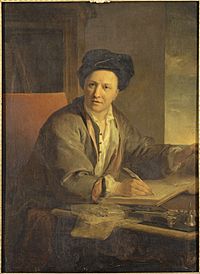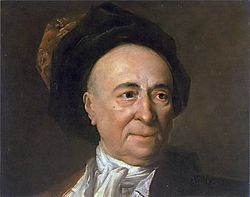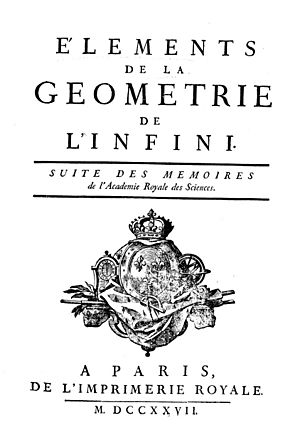Bernard Le Bovier de Fontenelle facts for kids
Quick facts for kids
Bernard Le Bovier de Fontenelle
|
|
|---|---|

A 1723 portrait of Fontenelle by Louis Galloche
|
|
| Born | 11 February 1657 Rouen, France |
| Died | 9 January 1757 (aged 99) Paris, France |
| Occupation | Essayist |
| Relatives | Thomas Corneille and Pierre Corneille |
Bernard Le Bovier de Fontenelle (born February 11, 1657 – died January 9, 1757) was a famous French writer. He was a very important member of three of France's top academies. He was known for making scientific ideas easy to understand for everyone. This was during a time called the Age of Enlightenment, when new ideas were spreading fast.
Contents
About Fontenelle
Fontenelle was born in Rouen, France. This city was the capital of Normandy back then. He passed away in Paris, just one month before his 100th birthday! His mother was the sister of two famous French playwrights, Pierre Corneille and Thomas Corneille. His father, François le Bovier de Fontenelle, was a lawyer.
Fontenelle studied law, but he didn't stick with it for long. He decided to spend his life writing about thinkers and scientists. He especially liked to defend the ideas of René Descartes, a famous philosopher. Fontenelle was great at explaining complex topics. He helped many people understand science better. He was also known for his friendly arguments.
He went to school at a college run by the Jesuits. It's now called the Lycée Pierre Corneille. Even at school, he loved literature and was very good at it.
Fontenelle also knew many other important thinkers of his time. These included Pierre Gassendi, René Descartes, Thomas Hobbes, and the famous mathematicians Blaise Pascal and his father Étienne Pascal.
His Early Writings
Fontenelle started his writing career as a poet. He wrote a poem in Latin when he was only 13 years old. He tried to win prizes from the Académie française (French Academy) many times, but he never won.
In 1680, his play called Aspar was a complete failure. Fontenelle even burned it himself! But his opera story, Thétis et Pélée, was a huge success in 1689.
In 1685, he published a collection of letters called Lettres galantes du chevalier d'Her.... It showed what society was like back then and became popular right away. In 1686, he wrote Relation de l'île de Bornéo. This book used a story about two princesses to talk about religious ideas.
But his most important early work was Nouveaux Dialogues des morts (1683). This book really showed his talent as a writer.
Three years later, he wrote Entretiens sur la pluralité des mondes (1686). This book was very influential. It talked about the idea that there might be many worlds in the universe. He wrote: "Behold a universe so immense that I am lost in it. I no longer know where I am. I am just nothing at all. Our world is terrifying in its insignificance."
Later Life and Works
Fontenelle moved to Paris in 1687. That same year, he published Histoire des oracles. This book caused a lot of discussion among religious and philosophical thinkers. It suggested that ancient oracles were not supernatural.
The Church was suspicious of his ideas. A Jesuit named Jean-François Baltus wrote a long book against it. But Fontenelle was a peaceful person and chose not to argue back.
In 1688, he wrote Digression sur les anciens et les modernes. In this book, he supported "modern" ideas in a big debate happening at the time.
Fontenelle lived a very long life. When the famous writer Jean-Jacques Rousseau met him in 1742, Fontenelle was 85. He gave Rousseau advice: "You must courageously offer your brow to laurel wreaths and your nose to blows." This meant to be brave and accept both success and criticism.
He loved to eat, especially strawberries. He even said that strawberries helped him live so long! When he was 92, people said he was as lively as a 22-year-old. Once, when he met a beautiful woman, he reportedly told her, "Ah Madame, if only I were eighty again!"
Member of the French Academies
In 1691, Fontenelle became a member of the French Academy. This was a big achievement, even though some people like Jean Racine and Nicolas Boileau-Despréaux tried to stop him. He was also a member of the Academy of Inscriptions and the Academy of Sciences.
In 1697, he became the permanent secretary of the Academy of Sciences. He held this job for 42 years! In this role, he wrote about the Academy's work. He also wrote "éloges," which were speeches praising the members who had passed away. These speeches were known for being simple and graceful.
One of his most famous "éloges" was about his uncle, Pierre Corneille. Fontenelle's other important books include Éléments de la géometrie de l'infini (1727) and Théorie des tourbillons (1752). In the latter, he supported René Descartes' ideas about gravity, even though Isaac Newton's ideas were becoming more popular.
Fontenelle was known for making his writings easy to understand. His style was almost like a story. This helped people who weren't scientists learn about new scientific discoveries. He encouraged everyone to be interested in "natural philosophy" (science). He was great at explaining ideas, even if he didn't come up with new scientific theories himself.
His Legacy

Fontenelle was very popular in French society. Many people respected him, almost as much as Voltaire. But unlike Voltaire, Fontenelle avoided making powerful enemies. He was good at being critical while also praising important people.
Fontenelle connects two different periods of French literature. He links the time of Pierre Corneille, Jean Racine, and Nicolas Boileau-Despréaux with the time of Voltaire, Jean le Rond d'Alembert, and Denis Diderot. He had qualities of both eras, but he truly belonged to the later, more modern period.
The Pluralité des mondes was even translated into modern Greek in 1794.
His Dialogues of the dead show how smart and witty he was. These books featured imaginary conversations between famous people from history. For example, Socrates talks to Michel de Montaigne. Roxelana and Anne Boleyn discuss politics. And Montezuma and Cortez talk about ancient wisdom.
In 1935, a lunar crater on the Moon was named Fontenelle in his honor.
See also
 In Spanish: Bernard Le Bovier de Fontenelle para niños
In Spanish: Bernard Le Bovier de Fontenelle para niños


